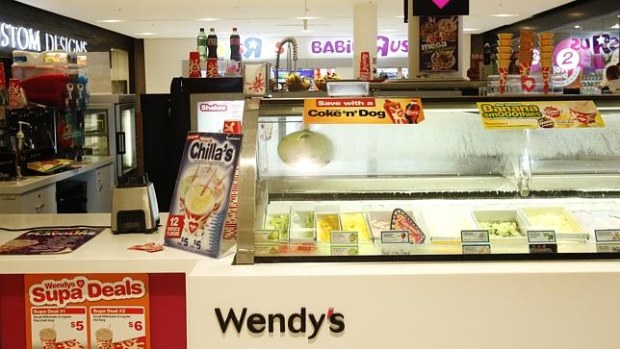Wendys shrinks stores to combat flat market
The 250-store Wendys ice-cream and hot dogs chain is shrinking the size of new stores by more than half as it seeks to reduce costs including rent.
The 250-store Wendys ice-cream and hot dogs chain is shrinking the size of new stores by more than half in response to a problem that retailers across a broad range of sectors are grumbling about – rents are too high and the economics often don’t stack up.
It’s an issue that even billionaire retail magnate Solomon Lew has railed about from time to time, that shopping centre owners and landlords haven’t adjusted to the change in retail conditions where online shopping has overturned traditional models and consumers want access to goods almost 24 hours a day.
The maturing fast food and convenience food store market in Australia where many of the powerful brands like McDonalds, KFC and Hungry Jack’s have been around for several decades now also means a rethink is required in a changing landscape.

Wendys chief Rob McKay said a major focus was on trying to get access to as much foot traffic as possible Photo: Louise Kennerley
Wendys chief executive officer Rob McKay said three new mini-format stores of between 10 to 12 square metres are trading solidly, and are less than half the size of traditional Wendys formats which average 24 square metres.
The firm, which endured a decline in sales in 2013-14 of just over 1 per cent to around $100 million, is also going even smaller in a separate format where it is setting up an extra 50 micro-stores as part of the food offerings at service stations operated by the On The Run chain owned by the Shahin family, through its Peregrine Corporation. Those micro-stores are just 4 square metres at their largest and offer a basic hot dog, five flavours of milkshake and soft-serve ice-creams.
The Shahin family have an estimated net wealth of $455 million, coming in at No. 102 on the latest BRW Rich 200.
Mr McKay said a major focus was on trying to get access to as much foot traffic as possible, but it must be at a level where the rents enable the business to make a decent return from the sales it generates.
“We want to get sustainable economics into the shopping centre environment,’’ he said. “One of the concepts we refer to is affordable traffic’’.
Wendys has 12 company-owned stores in its stable but most of its outlet are run under a franchised model. There are 48 outlets in Victoria, 39 in NSW, 45 in Queensland, 20 in Western Australia and 49 in South Australia, with the remainder in Tasmania, Northern Territory and New Zealand.
He said there was a fall-off in sales in the last few months of 2013-14, which accelerated after the federal budget. “Confidence did fall away after the budget,’’ he said.
The first Wendys store was established in 1979 and Mr McKay acknowledged that being part of the retail landscape for so long meant a revamp and a rethink was needed.
“I think it’s getting harder and harder if you’re just playing the same game’’, he said, adding that This was the same for all large fast food and convenience store chains. It’s all about a new consumer. It’s a 24-hour consumer’’.
The company is in negotiations with unnamed operators to roll out its micro-store format in service stations around Australia, while it has also set up a new concept called Wendys on Wheels, which is basically a van that locates itself outside high-traffic areas at sporting events and other big public festivals.
Wendys had started the new financial year solidly, and was hoping for a hot summer to deliver faster sales.
“We’ve actually started the year pretty well’’.
The new smaller format stores of between 10 square metres and 12 square metres are in Townsville in Queensland, Fairview Park in suburban Adelaide, and Pakenham in outer Melbourne. They offer 25 per cent of the traditional full-line product lines of a bigger store.
The smaller format stores also reduce labour costs because fewer people are required to staff the outlet.
Subscribe to gift this article
Gift 5 articles to anyone you choose each month when you subscribe.
Subscribe nowAlready a subscriber?
Latest In Companies
Fetching latest articles